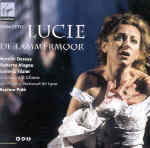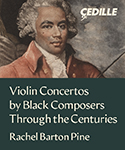In 1839 Donizetti had the opportunity to present his by-then famous and popular Lucia di Lammermoor in Paris. Since the available voices were slightly different from the original casting, what he did was far more than a translation: in many ways it amounts to a reworking of the opera. And while the result is interesting and certainly worth exploring, in the end it’s a less compelling opera than its Italian counterpart.
In this version, Lucia has lost her confidante, Alisa, making her the only woman in a world of men. In Alisa’s place, we have Gilbert (Normanno in the original), but the part has been expanded and the character is a true villain. Also gone are the lovely harp introduction to the opera’s second scene and the fountain aria, the latter having been replaced by a nice piece from the composer’s Rosmonda d’Inghilterra. Sadly, without the fountain scene, the reference to it in the Mad Scene makes little sense and there’s no musical evocation either. The Mad Scene is abbreviated, as is the role of the windbag preacher, Raimondo, who has no aria before the nicely bloodied Lucy reappears, and no duet with her in Act 2.
Most of the keys for arias and ensembles are a half- or whole-tone higher, so Lucie opts not to impress us with, say, a brain-bursting high-F at the close of the Mad Scene, instead taking a lower, written alternative. In fact, with the higher tessitura, the whole role is reduced emotionally; it’s almost back in the mouths of the likes of Lily Pons, Roberta Peters, et al. Of course, Natalie Dessay is a superb, interesting, dramatically right-on artist, so she’s moving and sings gorgeously. But don’t expect any Callas-like insights: the whole character is somewhat shallower and chirpier.
Roberto Alagna, singing in stunning French, is ardent, loving, and far too loud most of the time as Edgard. I don’t mind the occasional strain, but I did feel he was yelling at me part of the time. (At the close of the Act 1 duet, Alagna takes high E-flat and Lucie takes a C as Donizetti wrote; Carreras and Caballé did the same on their Italian-language recording, and the effect is stunning.) Ludovic Tézier makes a mellifluous yet nasty Henri, and he and Alagna are exciting in the Wolf’s Crag scene. Nicholas Cavalier impresses as Raymond, and Yves Saelens and Marc Laho are effective as Gilbert and Arthur respectively.
Evelino Pidò leads an elegant reading, although I occasionally felt that his attention to detail was hampering the flow. There’s another French-language Lucie available (on Dynamic), and it’s pretty good; but if you must own one, this one should be it. An oddity, worth it for the investigation and for Dessay–but it’s not Lucia di Lammermoor at its most successful. [2/14/2003]
































